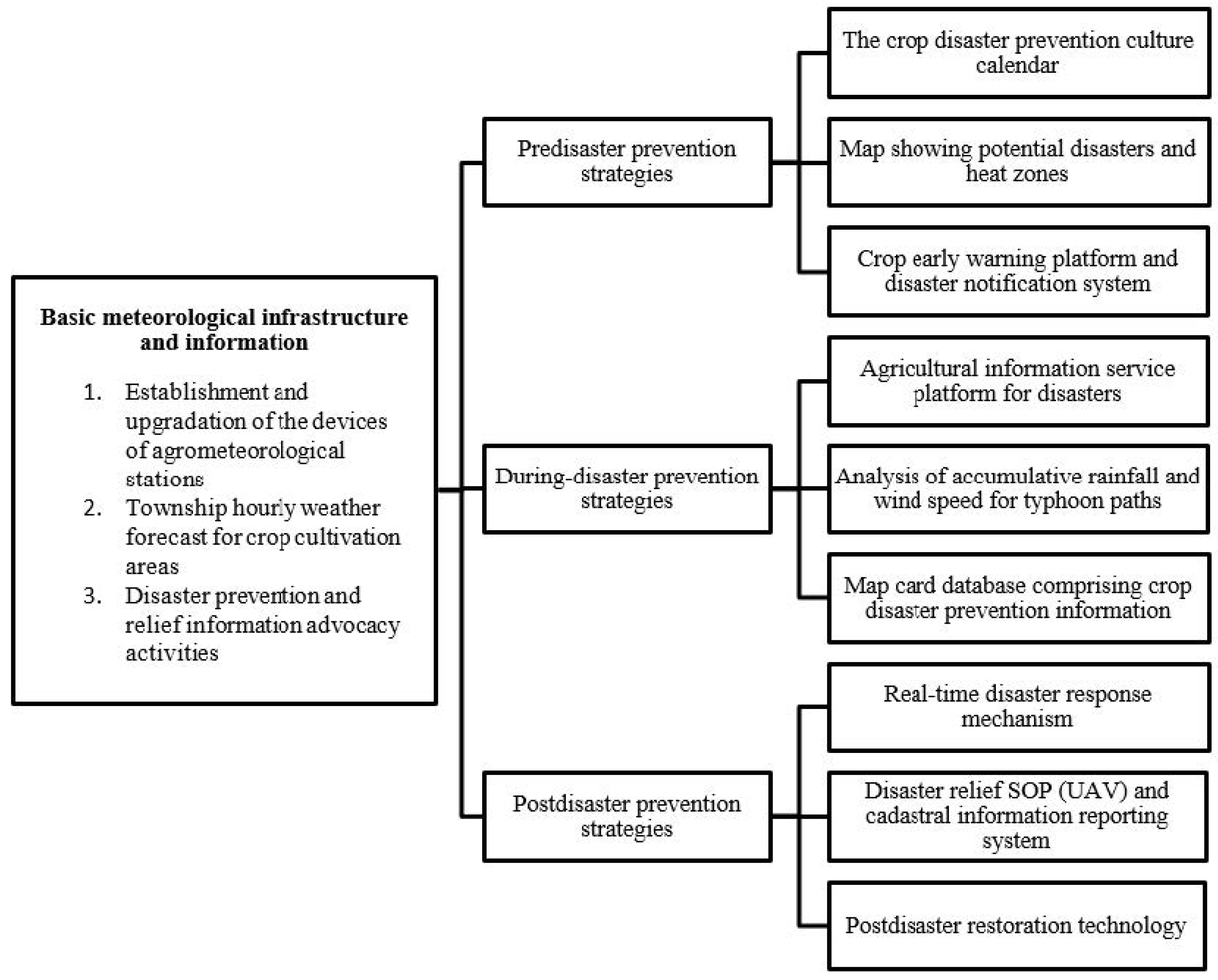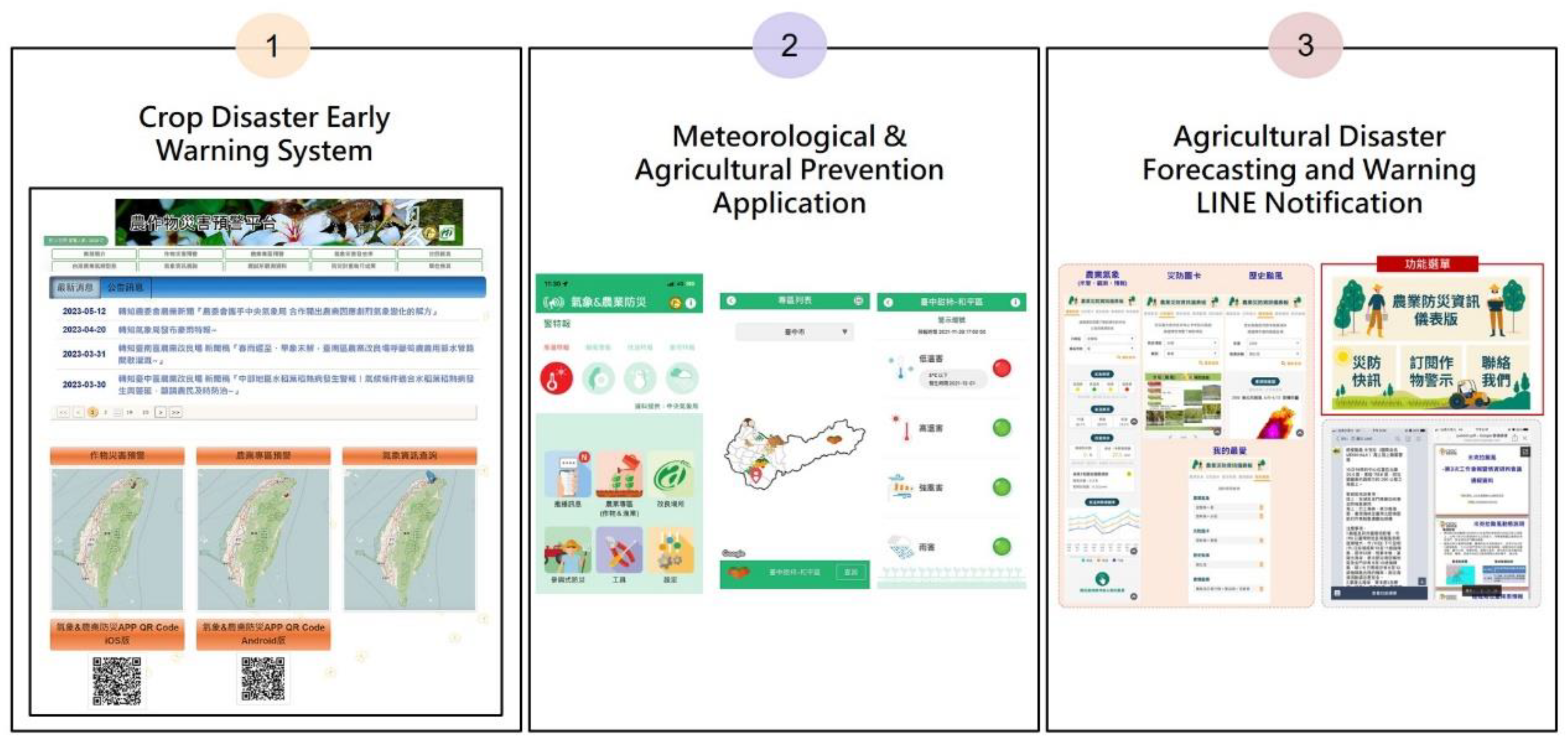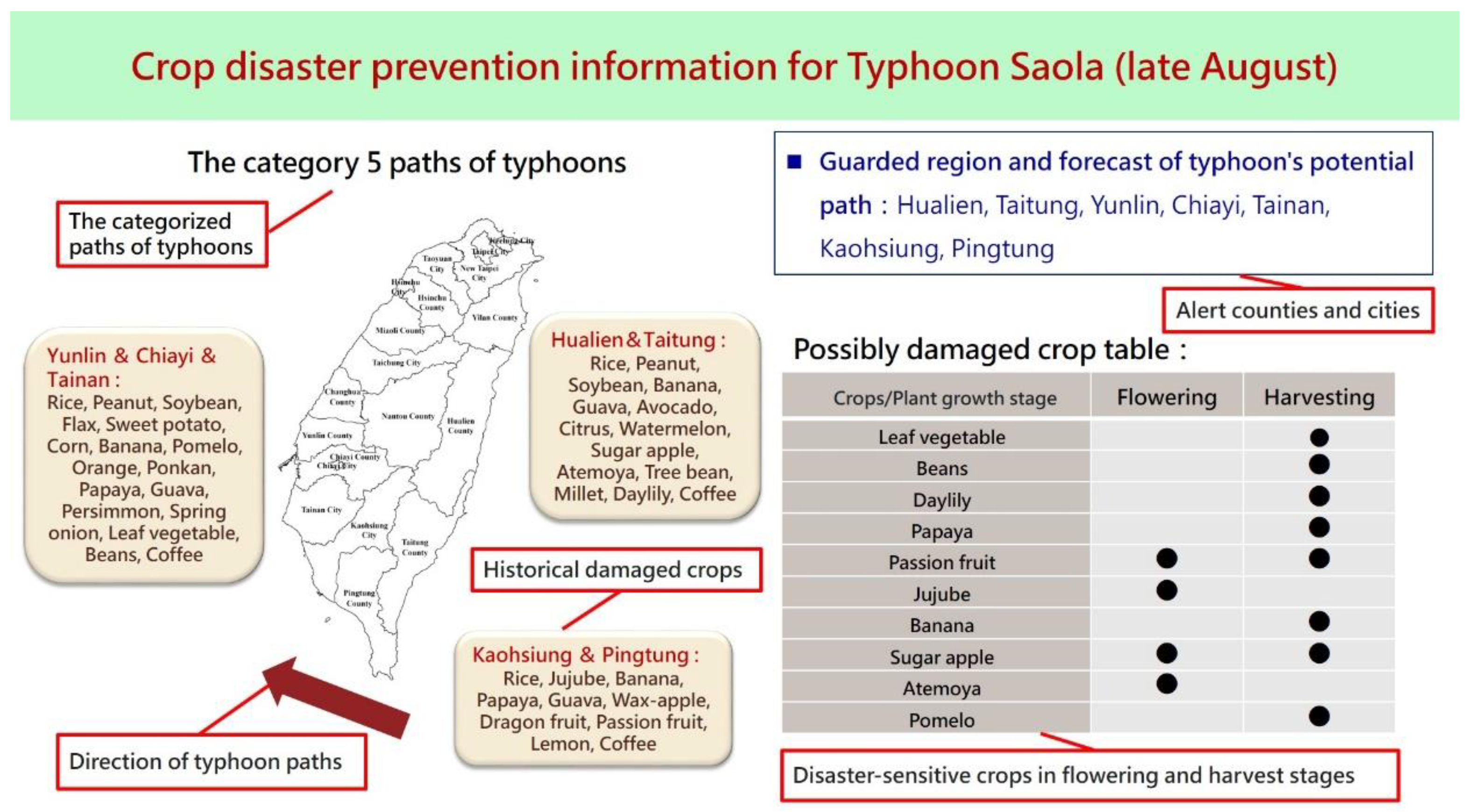3.1. Basic Meteorological Infrastructure and Information
Information on weather forecasts and disaster warnings comes from real-time observation data. Regarding the current situation of weather station installations over agricultural production areas in Taiwan, our Ministry of Agriculture and the Central Weather Administration cooperated to establish the “Agricultural Meteorological Observation Network” in 1986. A total of 17 agricultural meteorological stations have been established. However, after 30 years, the Agricultural Meteorological Observation Network has experienced problems such as outdated instruments and poor quality of observation data. Therefore, the Ministry of Agriculture and the Central Weather Administration once again cooperated to upgrade existing agricultural meteorological stations and establish new meteorological stations in consideration of disaster hotspots or important agricultural production areas. Consequently, there were a total of 176 agricultural meteorological stations by 2021, and agricultural meteorological station observation data were available for data download by personnel affiliated with the Ministry of Agriculture for agricultural information system development, disaster assessment, and the provision of crop cultivation guidance to farmers. This is very helpful for meteorological information push services [
16]. In addition to increasing the density of weather stations, the quality of observation data is also very important. We have established a meteorological data verification system. When the data are found to be unreasonable, the system will immediately notify the operator through communication software to eliminate obstacles or replace sensors. The assurance of data quality is contingent upon the establishment of a comprehensive maintenance mechanism.
There is a huge demand for weather forecasting services, particularly concerning disaster warning and agricultural operations. At present, the Central Weather Administration offers township forecasts with high spatial resolution, where forecasts are set at grid points based on the locations of township and district offices. However, agricultural production areas are often far away from urban areas, and, therefore, existing forecast points are of limited help to farmers in field management. To tackle this issue, we established a fine-scale weather forecast service system (
https://agr.cwa.gov.tw/, accessed on 25 April 2024) for important agricultural production areas. Currently, weather forecast services have been furnished for 392 agricultural production areas, with a forecast resolution of approximately 2.5 × 2.5 km. The forecasts extend for a period of 7 days, and the data are updated every 3 h. The authority has planned to add 30 new forecast points every year in the future. It is expected that every agricultural township and vulnerable crop production area can access weather forecast services.
3.2. Pre-Disaster Prevention Strategies
The susceptibility to weather differs from crop to crop. Beyond the genetic traits of crops, the way weather conditions are perceived in various growth stages plays a crucial role in determining the susceptibility of crops to climatic factors. For instance, rice exhibits remarkable tolerance to temperatures above 35 °C in the growth stage; yet, high temperatures in the flowering or grain-filling stages may lead to rice’s sterility or quality degradation [
17]. Moreover, elucidating the disaster probability in individual growth stages of crops, coupled with crucial thresholds identified by farmer interviews, simulation experiments, and literature reviews, can serve as a basis for developing disaster warning systems. At the same time, to understand the relationship between crop growth period and disaster critical value and also integrate the cultivation and management suggestions required during the crop growth process, our team compiled a “disaster prevention cultivation calendar” for economically important crops, including crop growth stages by “month”, possible meteorological disasters, disaster-causing meteorological critical values, disaster prevention suggestions and measures, fertilizers, and pest and disease management. This calendar is more helpful for disaster prevention awareness.
Figure 3 shows the established mango disaster prevention cultivation calendar, which includes mango growth stages from January to December of the year, cultivation management suggestions, possible disasters, and critical disaster-causing conditions. At present, the disaster prevention cultivation calendar for 76 economically important crops has been completed. The disaster cultivation calendar has been posted on the Internet for reference by all walks of life. However, some critical disaster conditions are difficult to determine, especially rainfall and wind speed. For crops that currently have no relevant data, heavy rain level (≥80 mm per day) and level 10 wind speed (Beaufort wind force scale) are used as default values, which will be updated with new information.
This program combined crucial thresholds for crops and fine-scale weather forecasts to establish the desired “crop disaster early warning system” (
https://disaster.tari.gov.tw, accessed on 25 April 2024) (
Figure 4). It can automatically determine the probability of agricultural meteorological disasters, with green, yellow, and red lights representing normal, caution, and warning levels, respectively. The display method is acceptable to farmers and is conducive to information promotion. Additionally, the system provides access to the most recent activity information, instant observational data, weather forecasts tailored for farming sites, updates on disasters, and historical data, such as Taiwan’s agricultural disaster rates, agricultural climate patterns, and maps indicating hotspots. It also includes a disaster prevention cultivation calendar, information on twenty-four solar terms, and achievements of the agricultural disaster prevention program. The abundance of agrometeorological and disaster prevention information aims to assist farmers in reducing disaster-induced crop losses. In addition, we explored a smartphone application system to provide farmers with convenient access to crop disaster information (
Figure 4).
3.3. During-Disaster Prevention Strategies
When a disaster is approaching, what information services can assist farmers? We explored an “agricultural information service platform for disaster” available at
https://eocdss.ncdr.nat.gov.tw/web/MOA, accessed on 25 April 2024 to furnish details on the prevailing crop growth status in disaster-prone areas, roadway conditions in agricultural production sites, and disaster prevention SOPs. Taking a typhoon as an example, once the disaster probability hits a specific threshold when the typhoon’s path is determined, the estimated strong wind speed reaches the level of crop damage; this information will be disseminated to agricultural extension stations, farmers’ associations, and crop cultivation and trade coalitions. Subsequently, the dissemination of disaster information and prevention measures will occur through messaging services, the Internet, and communication channels. Furthermore, during government disaster response meetings, decision-makers can promptly access agricultural disaster information presented by weather and hydrological monitoring maps. When the possibility of disasters increases, farmers need to be reminded to take precautions. When a disaster occurs, the forecast content and probability of the disaster must be revised at any time. The normal operation is to update every 3 h and then send the latest forecast results through the service platform, which will provide disaster information, including typhoon paths, estimated rainfall, instantaneous maximum wind speed, areas prone to flooding, and other information. On the other hand, the service platform will integrate the actual growth conditions of crops in each district, especially crops in the harvesting and flowering stages. The actual growth status of crops and the degree of disaster impact in each district will be reported immediately by researchers from various experimental units across Taiwan. Additionally, it will provide various disaster prevention suggestions that are integrated into disaster early warning briefings and graphical presentations for reminding farmers to take disaster prevention actions, where suggestions are updated based on real-time disaster information.
Given the diverse impacts of typhoon tracks on different locations, the Central Weather Administration has selected nine typhoon tracks for Taiwan. Moreover, certain areas may not directly face typhoons but are susceptible to heavy rains and strong winds due to the complex terrain in Taiwan. Therefore, each typhoon event is classified based on historical agricultural damage and meteorological data, while warning areas associated with each path are divided for early warning purposes. According to the crops in the harvesting or flowering period at warning areas, a database of “crop disaster prevention information map cards” is established (
Figure 5). Currently, map cards are produced biweekly, targeting disasters such as cold damage in April, heavy rain damage from May to July, southwest airflow from July to November, and nine historical typhoon paths from May to November. The information on map cards includes the estimated risk of agricultural crops being damaged, enabling farmers to quickly browse the crops that require attention during this disaster.
Agricultural information not only identifies crop production areas with a higher risk of disasters and the types of crops that may be affected but also offers disaster prevention (mitigation) suggestions. These suggestions focus on various crops such as rice, grains, fruits, vegetables, flowers, and greenhouses while providing prevention and control measures with text and illustrations. The disaster awareness map card tool was confirmed by agricultural disaster response procedures, and crop experts in each field immediately released disaster warning information to farmers for carrying out disaster reduction work in the field as soon as possible. For example, when a typhoon approaches, fruit farmers need to dredge or overhaul the drains, fix the brackets or branches, reinforce nets and facilities, manage the height of dwarf fruit plants, and prune leaves (
Figure 6). Based on simple photos, farmers can carry out the prevention procedure to reduce losses. The map card is like a checklist for disaster prevention measures, and farmers can confirm and complete the disaster prevention and preparation work.
In response to approaching typhoons, the central disaster response is mostly initiated when a sea warning is issued. Various administrative departments engage in tasks such as inspecting drainage gates, coordinating highway traffic responses, regulating ship entry, and managing class suspension. However, the agricultural warning is initiated three days before the sea warning. The main reason is that agricultural preparedness requires more time. For example, early harvesting of rice or fruits involves the deployment of harvesting machinery and manpower. However, the earlier the disaster warning, the higher the associated uncertainty. All agricultural operators should understand that it is still difficult to grasp the path of a typhoon invading Taiwan. The closer it is to Taiwan, the more accurate its path and landfall location will be. However, since the time of a typhoon invading Taiwan is easier to predict than its path, disaster prevention measures can be implemented based on the invasion time. For example, Hualien County is one of the taros-producing areas in Taiwan, but it is located in high-typhoon-prone areas. Farmers often trim taro leaves to prevent strong winds from lifting up the roots. However, trimming taro leaves will delay ripening. Therefore, it is recommended that farmers first evaluate the time required for trimming taro leaves. For example, if it takes one day, they will decide whether to trim leaves to prevent the typhoon based on the forecasted path provided to the Central Weather Administration the day before the predicted typhoon invasion. By familiarizing themselves with disaster uncertainties and response operations procedures, they can reduce the risk of typhoon damage.
3.4. Post-Disaster Prevention Strategies
Following a disaster, the main responsibilities of the government involve providing emergency relief funds and engaging in rehabilitation efforts. Yet, the government provides relief funds to encourage farmers to resume farming based on the degree of crop damage, but the determination is frequently a subject of controversy. The use of unmanned aerial vehicles (UAVs) for efficiently assessing landscapes, disaster regions, and agricultural damage enhances the creation of an imagery database pre- and post-disaster [
18]. This not only helps address controversies but also allows for a more accurate estimation of crop losses. In this study, utilizing high-precision crop image recognition techniques specifically developed for establishing an SOP and collecting essential information on cultivation and disaster areas, UAVs equipped with a global positioning system (GPS) can capture high-quality images pre- and post-disaster. Subsequently, these images are analyzed with cadastral data and the geographic information system (GIS). The present program deploys UAVs to record real-time images, enhancing disaster investigation and rescue operations. For instance, paddy fields damaged by heavy rain during the monsoon season in June were monitored. The UAV images captured in this program offer high ground resolution (3.5 cm) with 3D point clouds. These resources are crucial for image discrimination, aiding in the creation of a digital surface model (DSM) to assess rice lodging [
19,
20]. Initially, the maximum likelihood method was applied to performing supervised classification on images to obtain rice lodging areas. Subsequently, the Pix4D Mapper Pro (Pix4D) was employed to generate 3D point clouds, facilitating the development of a DSM to classify rice lodging. We achieved an 85% accuracy in discriminating rice lodging through supervised image classification and an 87% accuracy in lodging level classification using the DSM. The results suggest that UAVs are capable of offering real-time images capturing crop damage caused by meteorological disasters, facilitating image recognition on rice lodging levels with satisfactory accuracy (>85%). Future research can employ both UAV and image recognition techniques in targeted crop fields. The outcomes of image classification were superimposed onto the administrative boundaries of rice paddies to create a GIS-based support system for discerning agricultural damage. As a result, the manpower and time needed for detecting and monitoring crop damage were significantly reduced.












